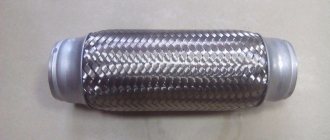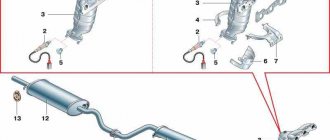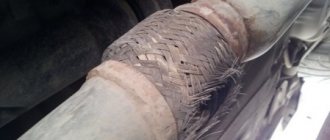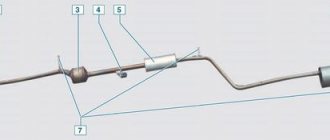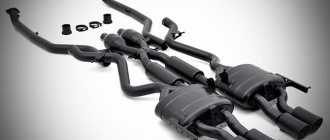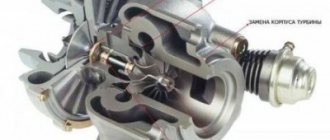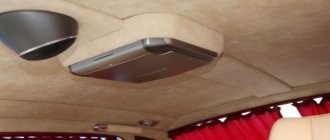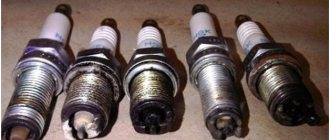How to install corrugation without welding
Corrugation does not have an exact service life, since it largely depends on the quality of the material
Welding is far from the only and not the most optimal method of installing corrugations. The fact is that corrugation does not last long. No one can predict its exact service life, since the quality of materials is completely different, as are the operating conditions. But no matter how carefully we weld the corrugation to the muffler, sooner or later it will have to be cut off. Therefore, in our deep conviction, the most optimal installation method is installation without welding. Welding basically serves to securely attach the corrugation rings to the exhaust pipe. Not particularly trusting cold welding, many do as described below.
A corrugation of the required length is placed on the prepared surface of the pipe, after which holes with a diameter of up to 6 mm are drilled in the rings and in the pipe. A thread is cut on the assembly assembly using a tap. After which the connection is disassembled, carefully coated with sealant for exhaust pipes, the bolts are coated with sealant and tightened. As a result, we have reliable fastening of the corrugation rings to the pipes without welding, and the sealant ensures the tightness of the connection. The number of bolts can be from 6 to 8 pieces depending on the diameter of the exhaust pipe.
Causes of muffler failure and preventive measures
It is easier to prevent a disease than to treat it later. This statement is also true for car breakdowns.
Of course, it is impossible to avoid all the nuances on the road. But knowing about the dangers that threaten the elements of a car’s exhaust system, you can try to use preventive measures to delay the occurrence of a particular malfunction.
If the car is used constantly, then sooner or later problems with the muffler will arise, regardless of the quality of the material from which this part is made. Located in the lower part of the car, this part is constantly exposed to the abrasive effects of sand and stones falling on its surface. And if, when the car is moving, a fairly large solid object ends up between the wheels, then the muffler can be completely destroyed from a strong impact.
Therefore, the main rule for extending the life of the unit is to drive the car carefully.
The muffler is connected to the exhaust system via threaded connections, so if the nuts are not tightened well enough, this part can be lost while the vehicle is moving. To prevent this from happening, the condition of the threaded connections of this element of the exhaust system should be checked from time to time.
The muffler often becomes unusable due to metal burning, but this process cannot be completely stopped. The failure of this part as a result of thermal and corrosive effects can be slightly slowed down only by treating the inner surface of this part using graphite impregnation.
If, despite all the preventive measures taken, the muffler burns out or its body is damaged as a result of mechanical stress, then many owners immediately become interested in the question of how to connect the muffler pipes without welding.
Such repairs can be carried out at home using a special sealing compound.
Repair of muffler mounting
Mitsubishi Galant American, AT Logbook Replacing the muffler pipe gasket Fa1 740-908
No matter how durable the cushions are, time and harsh operating conditions affect them negatively. Due to increased wear and tear, they also fail. Therefore, they require replacement over time. Fastening repair seems at first glance to be a simple and uncomplicated matter. But this is not so, because given the fact that the fasteners located under the bottom of the car are constantly exposed to moisture, they can rust and unscrewing them will be quite difficult. Also, if there is no hole, you will need to flounder under the car itself, which significantly complicates the process of disconnecting the muffler.
But if at the same time there is still no money to purchase an airbag or to contact a service center, then you have to use your ingenuity and come up with a mount yourself (create it from scrap materials) - you won’t drive without a muffler.
When to repair flanges
Repairing a muffler flange connection is a popular task for service center specialists. They often encounter it during the restoration of the exhaust system, when they have to remove the muffler. Then it is discovered that the flange has failed for the same reasons as the muffler itself:
- regular temperature changes and, as a result, burnout of the part;
- contact with chemically aggressive exhaust gases;
- changes in humidity that lead to corrosion;
- exposure to dust, dirt, grease, etc.
In some cases, it is enough to perform a “cosmetic” repair of the muffler. But you must understand that this is a temporary measure that will not solve, but only delay the problem. If the flanges are strong enough, you can replace the gasket, fasteners and use a special mounting paste. It is used to seal small damaged areas and make the connection airtight.
Operating temperatures
Cars Toyota Corolla Corolla 100 Toyota Corolla AE101 GT Former
The components of this system operate at high temperatures. The exhaust manifold of a gasoline engine heats up the most; its temperature reaches + 1300 ºC. The remaining components operate at temperatures from + 1000 to + 250 ºC, which is much lower than the melting point of the adhesive base. Sodium silicate, well known as liquid glass, melts at a temperature of + 1088 ºC. From this we can conclude that such sealants have fairly good heat resistance. The exhaust gases of diesel engines have a lower temperature than those of gasoline engines. This means that such sealants are even more suitable for diesel engines.
When to apply sealant
The exhaust system operates under many damaging factors:
- High temperature, which can reach 1300 °C, creating a risk of burnout;
- Aggressive gas environment with the destructive effects of electrochemical substances;
- Constant vibrations and vibrations leading to wear;
- Possible mechanical damage from hitting an obstacle on the road.
The condition of the system also depends on the quality of previous repairs, if any. All these factors negatively affect the muffler, turning it into a consumable item that periodically needs inspection, repair or replacement.
It is easy to recognize a system breakdown - the symptoms are a change in the exhaust sound or exhaust gases entering the cabin. In the early stages of a problem, you can use a sealant. This affordable and easy-to-use solution can solve many muffler problems. Such a mass usually consists of various synthetic (acrylic, silicone, etc.), metal and ceramic (increasing bond strength and heat resistance) components.
Still, sealant is not a panacea for repairing a muffler. It only copes with minor damage - small cracks, burnt metal or gaskets, etc. Such repair of the exhaust system is a temporary measure to extend the service life, increasing it by a year and a half. After this time, the unit will still need to be replaced.
Sealants in the form of paste, glue and cement (including ceramic compounds) are best suited for repairing the rounded structures of the exhaust system - the pipes connecting the cavities, catalysts and other parts. If the driver has a quick repair kit with him, then a muffler breakdown even on the road will not cause much trouble.
Please note that sealants can only be used on external surfaces. Internal damage can only be eliminated by completely unpacking the muffler, which almost no one does these days, since it would be easier and cheaper to purchase a new unit.
Muffler sealant is usually a universal product and, in addition to repairing the exhaust system, can be used for:
Design and purpose of the exhaust system bellows
Toyota Corolla 1.6 Dual vvti Logbook Manual transmission oil
The photo shows a bellows for the muffler, used as a flexible connection in the exhaust system
A bellows for a car muffler is a corrugated metal pipe of a certain diameter and has a layer of braided insulation made of stainless or steel wire. Depending on the expected load on the corrugation, the braid can be located in one layer on the inside and in several layers on the outside. In Ford Focus 2, Mitsubishi Lancer 9, Volkswagen Passat B5, Renault Scenic cars, the manufacturer recommends installing corrugations with additional internal braiding and a flexible stainless steel pipe. In principle, such recommendations should be followed if the engine power exceeds 120 horsepower.
The corrugation avoids the transmission of vibration from the exhaust manifold to other parts of the muffler. Also, when replacing resonators, many install a short-length corrugation to dampen vibrations and temperature overloads in the area being repaired. Some manufacturers make automobile exhaust bellows to fit the factory diameter of the exhaust pipe with clamps. This design is easy to install, but is used infrequently due to the unreliability of the clamp fastening. Vibration loads are still quite high.
What is a flange and what function does it perform?
A flange is a small piece of metal—flat or otherwise shaped—with holes on the sides for bolts. The flange is used to create a tight connection between pipes in the exhaust system. Often there are flanges at the points where the muffler pipe is attached to the manifold. In tuned cars they are installed additionally in front of the main banks of the exhaust system.
The flanges are attached to each other using strong bolts. A gasket is placed between the spare parts, and a heat-resistant ceramic seal is used to obtain a tight connection.
Do-it-yourself muffler mounting options
First, you need to place the car on level ground, jack up the rear part, and place a support in the form of bricks or logs under the beams. Before carrying out repairs, you should take care of safety and place locking elements under the wheels to prevent the car from rolling. This measure is mandatory because the vehicle must remain stable when unscrewing old connections, which often requires serious physical effort.
Having securely secured the car, you can begin to dismantle the muffler. Depending on the design of the exhaust system, the basic set of tools differs. In most cases, you will need pliers and two 10mm wrenches. Before starting work, it is advisable to wash the joints with water or special compounds that dissolve rust. This will speed up the process and keep the threaded connections in good condition.
Next, you can proceed to removing the old and installing a new suspension. A clamp is fixed in it, the ends of which cover the surface of the muffler. The device is secured with a bolt. It only takes an experienced professional a few minutes to complete the procedure. If it is impossible to purchase fasteners or in order to save money, you can replace the clamp with an old timing belt. To install it, you should prepare the following tools:
- drill;
- head (13 mm);
- bolts with washers (4 pcs. 3 cm each) and nuts;
- key to 10.
First of all, the muffler mounting bracket and the worn suspension are dismantled. Holes are drilled on both sides of the bracket in the places where the suspension was installed. Next, they cut off part of the belt and make holes in it, the ends of the product are bolted to the bracket. Mounting the muffler in this way will save money on purchasing new fastening elements. Some craftsmen use a collet connection to clamp staples.
The exhaust system is one of the most important parts in a car. The performance of the vehicle depends on its condition. That is why, when the first signs of damage occur, you should replace the muffler fastening elements with new ones or ensure reliable fixation with improvised materials.
Flange connection repair
If the flange fails, the decision is yours: replace or repair it. Both scenarios will help implement the service wizard. They will advise on the operation of the exhaust structure and offer the optimal solution for a particular vehicle.
To make an appointment for repair or replacement of the flange, use the contact number listed on the website. We accept clients from St. Petersburg and the region daily from 10:00 to 23:00. We will find reliable components from our trusted suppliers, saving your time and money.
Repair
Repairing the muffler corrugation with your own hands is impossible, and they won’t do it in a workshop. But the need for invention is cunning. It’s hard to call this a full-fledged repair, but for some time, up to one month, you can drive without any noise. But then change it anyway. You will need high-temperature glue, bandage or gauze. It is necessary to saturate the material with glue and wrap it around the corrugation many times. The bigger, the better.
But there is one unpleasant side to this method. Regular epoxy will flow and splatter the bottom at a temperature of 90-120°C. You need a resin or other type of glue with an operating temperature of at least 300°C
When choosing an adhesive, you should pay attention that the better the heat resistance, the higher the rigidity and fragility, and the corrugation is always in motion. Installing a car muffler corrugation using glue may be more expensive than welding
Design of fastenings for a car muffler
The muffler is fastened using special clamps that encircle it and are fixed using hangers and brackets located on the vehicle body. Some foreign-made car models are equipped with an entire shock-absorbing system, but simpler options are implemented on domestically produced vehicles.
Suspensions are made of durable and reliable material that can withstand high tensile loads. An important factor is the ability of fastening elements to withstand the negative effects of the environment, since the bottom comes into contact with moisture, chemicals, and gravel. The exhaust system is subject to shaking, vibrations, and sudden temperature changes. That is why strict requirements are put forward for the quality of fastening.
The design involves limiting the contact of the muffler with body parts and other parts, otherwise this may lead to their damage due to high temperature. In addition, constant vibrations of the exhaust pipe can cause mechanical wear of adjacent elements.
For Russian-made cars
At home, you can easily repair a GAZ 31 car. To do this, you need to jack up the rear part and place bricks under the supporting parts. The tools used are two 10mm wrenches and pliers, with which you can remove the old fastening system. You must first purchase a new mounting pad for the muffler and a clamp.
The cost of these elements is no more than 500 rubles, and the entire installation procedure takes no more than 30 minutes (most of the time is spent on unscrewing stuck nuts).
VAZ family
The main characteristic when choosing muffler mounts for VAZ cars is the design number. This value is individual for each model, which is due to the design features. For the VAZ 2108-2115, a set of “gingerbreads” is suitable, which consists of 5 products, identical in size and shape. Every owner of the domestic automobile industry knows how often these suspensions break, since they withstand severe physical stress and constant temperature changes.
For models 2110, 2111, 2112, 2113, 21213, kits from 2108 are used, but with a reinforced design. People call them “alarm clocks” due to their similar shape. Thanks to a thoughtful design and the use of reliable materials, the developers managed to increase the service life of parts. To securely fasten the muffler, clamps of various sizes are used. As an addition, devices for fastening chains are used. The design is durable and economical.
Other domestic brands
You can fix the Gazelle muffler yourself at home, and repairing it will cost about 500 rubles. The exhaust system of a vehicle consists of an exhaust manifold, catalyst, downpipe, resonator, tailpipe and muffler. Restoration of fasteners occurs by replacing gaskets and brackets.
Muffler vibration
Very often, car owners are faced with the fact that vibration is felt in the cabin, and this is often associated with the exhaust system. Almost all cars have parts or connections that compensate for engine vibrations so that they are not transmitted to the exhaust system and car body. This is either a damper connection or a muffler compensator - corrugation.
The damper connection consists of 2 flanges with a connecting ring between them, connected by bolts with springs.
Due to the fact that this connection is movable, vibrations and vibrations of the exhaust system are reduced. Over time, the bolts with springs sour and rust, the connecting ring wears out and wears out, and the flanges simply rot. Because of this, the damper connection does not fulfill its task and the exhaust system becomes in a rigid, stationary position, resulting in vibration of the muffler. Also, a “muffler roar” may appear immediately or soon, because the flanges begin to cut and the exhaust pipe may also burst in weak spots due to vibration. If you are faced with the fact that your damper has failed, then it needs to be replaced with a corrugated one, since there are no repair damper connections.
Muffler corrugation (or bellows) - is a corrugated connection, with an external or external and internal braid. There are two-layer and three-layer corrugations. Inner braid and interlock .
Interlock is more reliable with a reinforced internal structure and is almost a complete analogue of the original.
In our AUTO-EXHAUST technical centers, you can replace the old corrugation or damper with high-quality Interlock corrugation at a price of 1,800 rubles (part + installation). The warranty on corrugation and labor is 12 months.
What can cause a corrugation or damper connection to fail?
1) Firstly, due to the fact that the service life of the corrugation is coming (100-150 t.km)
2) Due to physical impact. When you hit the muffler, when you hit a speed bump, if you press the muffler against the curb or pull the exhaust system “by a stump” or any other object, the first thing that happens is the corrugation or damper, because this is the weakest part of the exhaust system
3) Due to a clogged catalyst. In the case when the corrugation is in front of the catalyst, and it, in turn, is clogged, it creates back pressure and the corrugation breaks and burns out from the inside.
4) When the engine mounts are faulty or torn. In this case, there is an excessive load on the moving joints (corrugation, damper) and their service life is reduced several times.
5) When the elastic bands of the exhaust system suspension are torn. Again, there is an excessive load on these elements.
If you encounter such a problem , you can contact one of our technical centers, where they will give you a free diagnosis and, if necessary, fix the problem.
Here are our addresses
1) Moscow, Nizhegorodskaya street 74 t.
2) Moscow, Avtozavodskaya street 22a building 1 t.
3) Moscow, MKAD 53 km building 6 (inner side) t. (495) 999-26-09
4) Moscow, 1st Nagatinsky proezd 8 t. (495) 762-18-50


